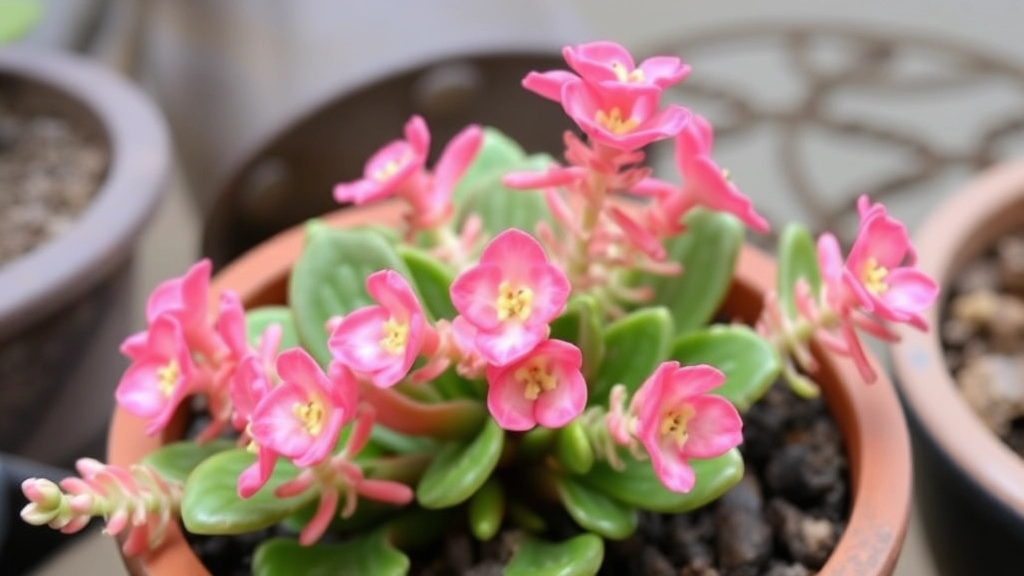Kalanchoe Paddle Plant Guide
Hey there! If you’re looking to dive into the world of the Kalanchoe Paddle Plant, you’re in the right place. This unique succulent is not only eye-catching but also super easy to care for. Whether you’re a seasoned plant enthusiast or a newbie, I’ll guide you through everything you need to know about this fabulous plant.
From its vibrant, paddle-shaped leaves to its low-maintenance needs, the Kalanchoe Paddle Plant is a perfect addition to any home. Stick around, and I’ll share some tips and tricks to keep your plant thriving. Let’s get started!
Are you looking for a unique and resilient houseplant that adds a touch of charm to your space? The Kalanchoe Paddle Plant, also known as Kalanchoe thyrsiflora, might be just what you need.
This succulent is renowned for its striking paddle-shaped leaves, which can grow quite large and display a beautiful green hue with a hint of red at the edges when exposed to sunlight.
## Key Characteristics
– **Origin**: Native to Madagascar, this plant thrives in arid conditions.
– **Growth Habit**: It can reach heights of up to 1-2 feet and spreads outwards, making it an eye-catching addition to any collection.
– **Flowers**: While primarily grown for its foliage, it can produce yellow or orange flowers in the right conditions.
The Kalanchoe Paddle Plant is not just visually appealing; it is also relatively low-maintenance, making it an ideal choice for both novice and experienced gardeners. For more detailed care instructions, you can refer to the [complete guide on caring for Kalanchoe Flapjack](https://planthq.org/how-to-care-for-kalanchoe-flapjack-complete-guide/). Additionally, if you’re interested in exploring other fascinating species, you might want to [discover 150 species of Kalanchoe succulent plants](https://planthq.org/discover-150-species-of-kalanchoe-succulent-plants/).
Ideal Growing Conditions for Kalanchoe Paddle Plant
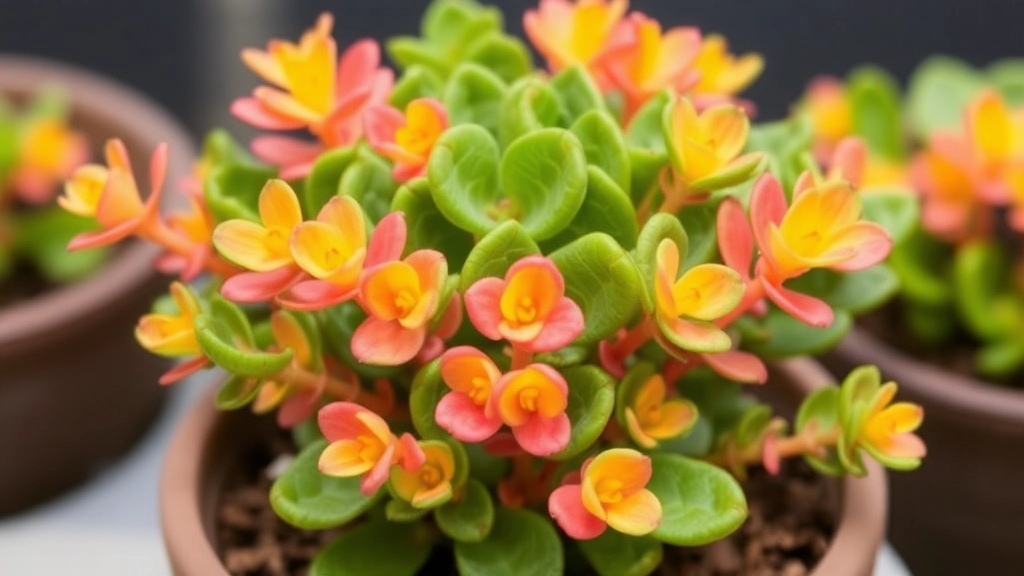
So, you’re keen on nurturing a Kalanchoe Paddle Plant? Great choice! But what’s the secret sauce to help it thrive? Let’s dive into the ideal growing conditions that will make your plant feel right at home.
Sunlight and Location
First off, light is key.
- Bright, Indirect Light: Kalanchoe Paddle Plants love bright, indirect sunlight. Think of a cozy spot near a window that gets plenty of light but isn’t blazing hot.
- Avoid Direct Sun: Too much direct sun can scorch those lovely leaves.
Space to Breathe
Next, don’t forget about space.
- Good Airflow: These plants appreciate good airflow around them. It helps prevent diseases and keeps them happy.
- Room to Grow: Make sure you give them enough space to spread out. They can grow quite wide!
Seasonal Changes
Lastly, keep an eye on the seasons.
- Summer: During the warmer months, they’ll thrive outdoors if the temperatures are right. Just make sure to bring them in if it gets too hot.
- Winter: In winter, they prefer to stay indoors where it’s warm.
Soil Requirements
When it comes to growing a Kalanchoe Paddle Plant, the right soil is crucial for its health and vitality.
Are you wondering what type of soil will keep your plant thriving?
Soil Composition
Kalanchoe Paddle Plants prefer well-draining soil that allows excess water to escape quickly. Here are some ideal soil characteristics:
- Cactus or Succulent Mix: A pre-made cactus mix is often the best choice, as it provides the drainage your plant needs.
- Perlite or Sand: Adding perlite or coarse sand to regular potting soil can enhance drainage and aeration.
- pH Level: Aim for a slightly acidic to neutral pH, around 6.0 to 7.0.
Container Choice
Choosing the right pot is just as important as the soil. Consider the following:
- Drainage Holes: Ensure your pot has drainage holes to prevent water from pooling at the bottom.
- Size: A pot that’s too large can hold excess moisture, while a pot that’s too small can restrict growth.
Repotting
Regularly checking the soil condition is essential:
- Signs of Repotting: If you notice roots growing out of the drainage holes or the plant seems stunted, it may be time to repot.
- Frequency: Generally, repot every 1-2 years to refresh the soil and provide more space for growth.
Watering Needs
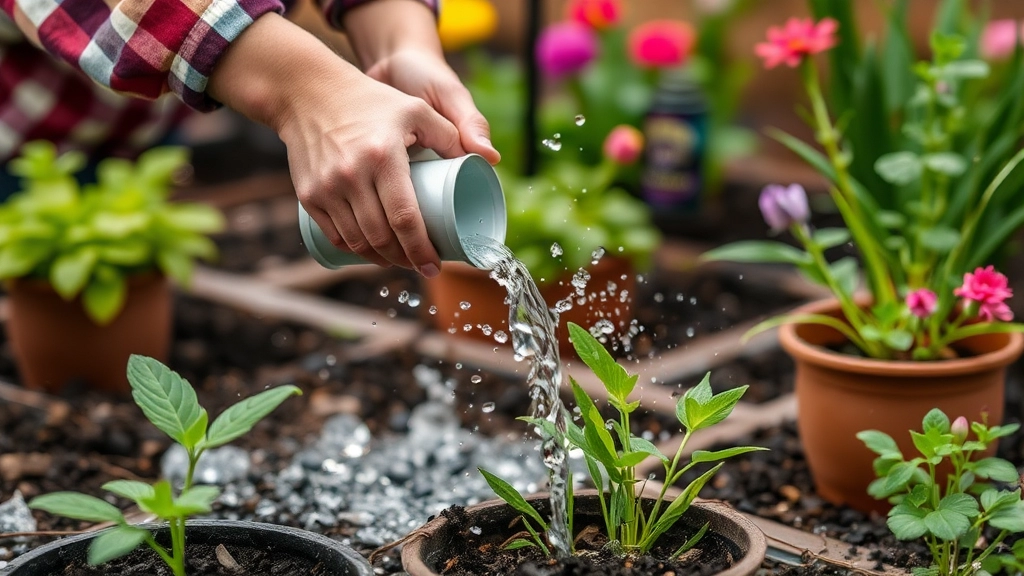
When it comes to caring for your Kalanchoe Paddle Plant, understanding its watering needs is crucial. Overwatering is one of the most common issues that can lead to root rot and other complications.
Key Watering Guidelines:
- Frequency: Water your Paddle Plant every 2-3 weeks during the growing season (spring and summer). In the dormant season (autumn and winter), reduce watering to once a month.
- Soil Check: Always check the soil moisture before watering. Insert your finger about an inch into the soil; if it feels dry, it’s time to water.
- Watering Method: Water thoroughly until it drains out of the bottom. This ensures the roots receive adequate moisture without sitting in water.
- Drainage: Ensure your pot has drainage holes. This prevents water from accumulating at the bottom, which can lead to root rot.
Signs of Overwatering:
- Yellowing leaves
- Mushy stems
- A sour smell from the soil
Tips for Optimal Watering:
- Use room temperature water to avoid shocking the plant.
- During hot weather, you may need to adjust your watering schedule to keep the plant hydrated.
Light Preferences
When it comes to the Kalanchoe Paddle Plant, understanding its light preferences is crucial for ensuring its vibrant growth and health.
Many plant enthusiasts often wonder, âHow much light does my Kalanchoe need?â
The Kalanchoe Paddle Plant thrives best in bright, indirect sunlight.
Key Light Requirements:
- Direct Sunlight: While it can tolerate some direct sunlight, too much can scorch the leaves.
- Indirect Light: A location with filtered light, such as near a window with sheer curtains, is ideal.
- Artificial Light: If natural light is limited, consider using grow lights, especially during the darker months.
Signs of Improper Light:
- Too Little Light: Leaves may become leggy and pale.
- Too Much Light: Leaves may turn brown at the edges or develop sunburn patches.
For more detailed care instructions, you can refer to our complete guide on caring for Kalanchoe Flapjack Flowers. Additionally, if you are noticing issues like leaf discoloration, our article on why Kalanchoe leaves turn red might be helpful.
Temperature and Humidity

Have you ever wondered why your Kalanchoe Paddle Plant isn’t thriving as much as you’d hoped?
Temperature and humidity play a huge role in its health.
Ideal Temperature Range
Kalanchoe Paddle Plants love warmth.
- Optimal Temperature: 20°C to 30°C (68°F to 86°F) during the day.
- Nighttime: They can tolerate a drop to around 10°C (50°F).
Too cold, and you risk stunted growth or even damage.
Humidity Levels
These plants are pretty forgiving when it comes to humidity.
- Ideal Humidity: 30% to 50% is perfect.
- Too Much Humidity: If it gets too humid, you might face issues like root rot.
If your home is too dry, consider placing a tray of water nearby to boost humidity without soaking the plant.
Quick Tips for Temperature and Humidity
- Avoid Drafts: Keep them away from chilly drafts or direct air conditioning.
- Monitor Temperature: Use a thermometer to ensure they’re in their happy zone.
If you’re keeping your Kalanchoe in a room that gets too hot or too cold, it could be time to rethink its spot.
VII. Fertilization Guidelines
As we consider the essential care for your Kalanchoe Paddle Plant, fertilization plays a pivotal role in promoting healthy growth and vibrant foliage.
Many plant enthusiasts often wonder, “How often should I fertilize my Kalanchoe Paddle Plant?”
Here’s a straightforward guide to keep your plant thriving:
- Frequency: Fertilize every 4-6 weeks during the growing season (spring and summer). This ensures your plant receives the nutrients it needs when it’s most active.
- Type of Fertilizer: Use a balanced, water-soluble fertiliser, preferably one high in phosphorus to encourage blooming. A ratio such as 10-10-10 or 20-20-20 works well.
- Dilution: Always dilute the fertiliser to half the recommended strength. This prevents over-fertilisation, which can harm your plant.
- Application: Apply the fertiliser to moist soil. This reduces the risk of root burn and helps the plant absorb nutrients more effectively.
- Signs of Nutrient Deficiency: Watch for yellowing leaves or stunted growth, which may indicate that your plant needs a nutrient boost.
Maintaining a consistent fertilisation schedule will help your Kalanchoe Paddle Plant flourish.
For more information on other varieties, check out our top Kalanchoe succulent varieties and care tips.
Pruning and Maintenance
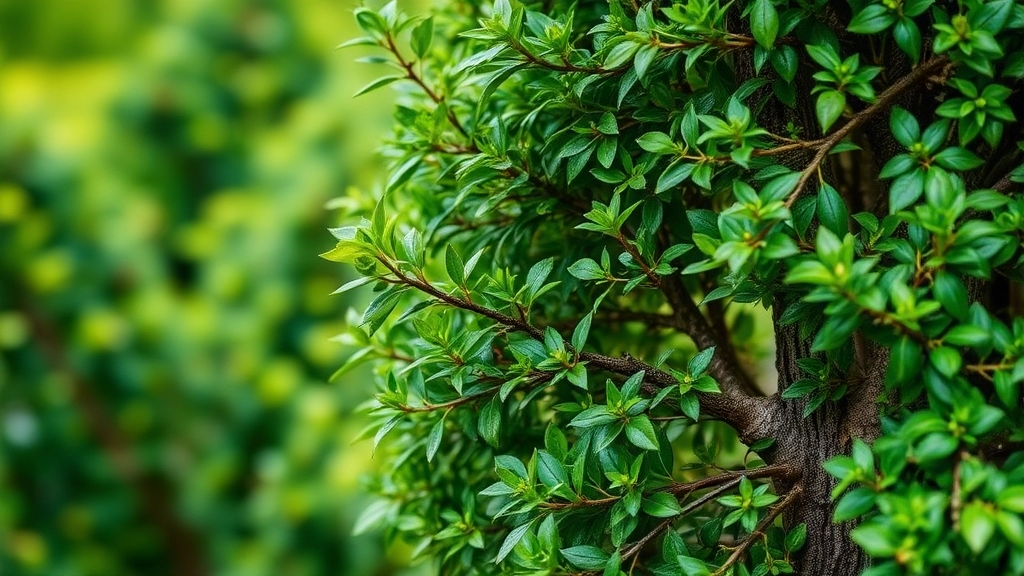
So, you’ve got your Kalanchoe Paddle Plant thriving, and you’re probably wondering how to keep it looking its best. Pruning and maintenance are key to ensuring your plant stays healthy and vibrant.
Why Prune?
Pruning isn’t just about aesthetics; it’s essential for the overall health of your plant. Regular pruning helps:
- Remove dead or damaged leaves
- Encourage new growth
- Maintain a tidy shape
When to Prune
Timing is everything. The best time to prune your Kalanchoe Paddle Plant is during the spring or early summer. This is when the plant is actively growing, making it easier for it to recover from cuts.
How to Prune
Here’s a simple step-by-step guide to get you started:
- Gather Your Tools: You’ll need sharp, clean scissors or pruning shears.
- Identify the Problem Areas: Look for any leaves that are yellowing or wilting.
- Make Clean Cuts: Cut just above a leaf node to promote healthy regrowth.
- Dispose of Cuttings: Keep your workspace tidy to prevent any pest issues.
Maintenance Tips
Keeping your Kalanchoe Paddle Plant in tip-top shape doesn’t end with pruning. Here are some easy maintenance tips:
- Dust the Leaves: Wipe them down with a damp cloth to keep them clean and photosynthesizing efficiently.
- Check for Pests: Regularly inspect for any unwanted guests like mealybugs or aphids.
- Rotate the Plant: This helps ensure even light exposure, promoting balanced growth.
Remember, less is often more. You don’t need to go overboard with pruning; a little attention goes a long way.
Common Pests and Diseases
As we delve deeper into the care of the Kalanchoe Paddle Plant, it’s essential to consider the potential threats that may hinder its growth.
Common Pests
Kalanchoe Paddle Plants can attract a variety of pests. Here are the most common ones to watch for:
- Mealybugs: These small, white, cotton-like insects can cluster on leaves and stems, sucking sap and weakening the plant.
- Aphids: Tiny green or black insects that can cause leaf curling and stunted growth.
- Spider Mites: These pests thrive in dry conditions, leaving fine webbing and tiny yellow spots on leaves.
- Scale Insects: Hard, shell-like pests that attach themselves to stems and leaves, draining the plant’s vitality.
Common Diseases
In addition to pests, Kalanchoe Paddle Plants can be susceptible to diseases:
- Root Rot: Often caused by overwatering, this disease leads to wilting and yellowing leaves. Ensure proper drainage to prevent this.
- Powdery Mildew: A fungal disease that manifests as a white powdery coating on leaves. It thrives in high humidity and poor air circulation.
Prevention and Treatment
To keep your Kalanchoe Paddle Plant healthy, consider these strategies:
- Regular Inspections: Check your plant weekly for signs of pests or disease.
- Proper Watering: Avoid waterlogged soil to prevent root rot.
- Neem Oil: A natural pesticide effective against many pests. Spray it on affected areas.
- Fungicides: Use as directed if you encounter fungal diseases like powdery mildew.
For more detailed tips on keeping your plant healthy, check out our Kalanchoe Paddle Plant Care Guide. Additionally, if you are dealing with issues like leaves turning red, our article on Kalanchoe Leaves Turning Red might be helpful.
Propagation Methods for Kalanchoe Paddle Plant
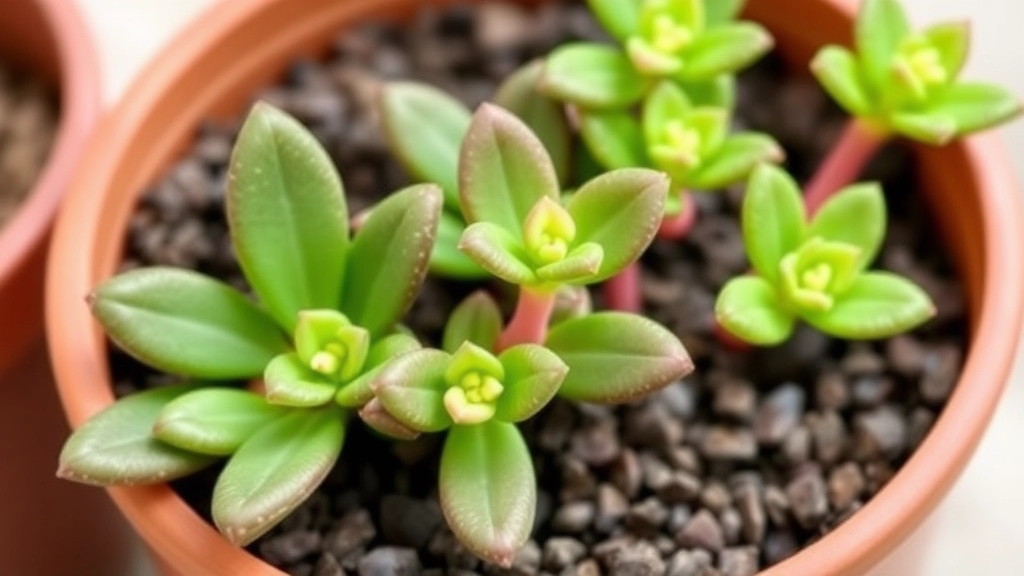
So, you’ve got your Kalanchoe Paddle Plant thriving, and now you’re wondering how to multiply that beauty?
Propagation is a fun and rewarding way to expand your collection or share with friends.
Leaf Cuttings
One of the simplest methods is through leaf cuttings. Here’s how to do it:
- Choose a Healthy Leaf: Pick a plump, healthy leaf from your plant.
- Cut It Off: Use a clean, sharp knife to detach it.
- Let It Callous: Place the leaf in a dry spot for a few days. This helps prevent rot when you plant it.
- Plant It: Once calloused, lay the leaf flat on soil or slightly bury the tip.
- Water Sparingly: Mist the soil lightly and keep it in bright, indirect light.
Offsets
Another easy method is to use offsets, or pups, that grow around the base of the plant.
- Locate the Offsets: Look for small plants at the base.
- Gently Remove: Carefully pull them away, ensuring some roots are attached.
- Replant: Place them in their own pot with well-draining soil.
Seed Propagation
If you’re feeling adventurous, you can also grow Kalanchoe from seeds, though this takes a bit longer.
- Sow Seeds: Sprinkle seeds on the surface of moist soil.
- Cover Lightly: Just a light dusting of soil will do.
- Keep Moist: Mist regularly, keeping the soil damp but not soggy.
Tips for Success
- Timing: The best time to propagate is during the growing season, typically spring and summer.
- Patience is Key: It might take a few weeks for roots to develop, so don’t rush it.
Propagation can be a delightful way to connect with your plants and enhance your space.
Seasonal Care Tips for Kalanchoe Paddle Plant
As we explore the seasonal care tips for the Kalanchoe Paddle Plant, it’s essential to understand that each season brings unique challenges and opportunities for growth.
Decorative Uses and Landscaping Ideas for Kalanchoe Paddle Plant
So, you’ve got your Kalanchoe Paddle Plant thriving, and now you’re wondering how to showcase it, right?
These stunning succulents aren’t just a treat for the eyes; they can be real showstoppers in your home or garden. Here are some creative ways to incorporate them into your space:
Indoor Decor
- Table Centerpieces: Place a Kalanchoe Paddle Plant in a stylish pot and use it as a centerpiece on your dining or coffee table.
- Window Sills: They love light, so why not line your window sills with a few? The vibrant leaves will catch the sun beautifully.
- Shelving: Mix them in with other plants on your shelves. Their unique shape adds a fun contrast.
Outdoor Landscaping
- Rock Gardens: These plants thrive in well-drained soil, making them perfect for rock gardens. Pair them with stones for a natural look.
- Container Gardens: Create a stunning container garden with a mix of succulents and cacti. The Paddle Plant can be the star of the show!
- Pathway Borders: Use them to line pathways. They’re low-maintenance and add a pop of colour without overwhelming the space.
Seasonal Displays
- Holiday Decor: During the festive season, you can dress them up with fairy lights or decorative pots to add a seasonal touch.
- Themed Displays: Change the pots according to the season. Bright, cheerful colours in spring or earthy tones in autumn can really set the mood.
Tips for Maximising Impact
- Mix and Match: Combine them with other succulents for a diverse look.
- Vary Heights: Use pots of different heights to create visual interest.
- Group Planting: Cluster a few together for a fuller effect.
The Kalanchoe Paddle Plant is not just a plant; it’s a versatile piece of decor that can elevate your space. For more detailed care instructions, check out our guide on growing and caring for Kalanchoe Luciae. Additionally, if you are interested in other Kalanchoe varieties, our comprehensive guide on Kalanchoe varieties might be helpful.
FAQs About Kalanchoe Paddle Plant
What are the ideal growing conditions for a Kalanchoe Paddle Plant?
The Kalanchoe Paddle Plant thrives in bright, indirect sunlight and requires good airflow. It’s important to provide enough space for the plant to grow. During summer, they can be kept outdoors if temperatures are moderate, but they should be brought indoors if it gets too hot. In winter, they prefer a warm indoor environment.
How often should I water my Kalanchoe Paddle Plant?
Watering frequency depends on the season. During the growing season (spring and summer), water every 2-3 weeks. In the dormant season (autumn and winter), reduce watering to once a month. Always check the soil moisture before watering and ensure your pot has drainage holes to prevent root rot.
What signs indicate that I am overwatering my Kalanchoe Paddle Plant?
Signs of overwatering include yellowing leaves, mushy stems, and a sour smell from the soil. If you notice any of these symptoms, reduce watering and check the drainage of your pot.
What temperature and humidity levels are ideal for my Kalanchoe Paddle Plant?
The optimal temperature range for Kalanchoe Paddle Plants is 20°C to 30°C (68°F to 86°F) during the day and around 10°C (50°F) at night. They prefer humidity levels between 30% and 50%. Avoid placing them in areas with drafts or direct air conditioning.
When and how should I prune my Kalanchoe Paddle Plant?
The best time to prune is during the spring or early summer when the plant is actively growing. Use sharp, clean scissors or pruning shears to remove dead or damaged leaves. Make clean cuts just above a leaf node to promote healthy regrowth.
Can I propagate my Kalanchoe Paddle Plant? If so, how?
Yes, you can propagate your Kalanchoe Paddle Plant through leaf cuttings, offsets, or seeds. Leaf cuttings involve detaching a healthy leaf, letting it callous, and then planting it. Offsets can be gently removed and replanted. Seeds can be sown on moist soil and lightly covered.
What are some maintenance tips for keeping my Kalanchoe Paddle Plant healthy?
Regularly dust the leaves with a damp cloth, check for pests, and rotate the plant to ensure even light exposure. These simple steps will help keep your plant in top shape.
What should I do if my home is too dry for my Kalanchoe Paddle Plant?
If your home is too dry, consider placing a tray of water near the plant to boost humidity without soaking it. This can help maintain the ideal humidity levels for the plant’s health.
References
-
Growing Kalanchoe Thyrsiflora (Paddle Plant): Tips and Tricks
-
Kalanchoe Paddle Plant Care: How To Grow And Care For Kalanchoe Thyrsiflora
-
Kalanchoe: How to Grow and Care for Kalanchoe Plants
